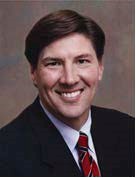
I would like to take the chair’s prerogative to bring home a point I think sometimes gets lost when it comes to Americans’ donations to our country’s philanthropic organizations.
To wit, it is commonly perceived that as the stock market goes, so goes giving. This is true to a point, but let’s stop and look at what happened last year: While the benchmark Standard and Poor’s 500 rose appreciably – 27.8 percent when adjusted for inflation, to be exact –total giving rose much more modestly – by “only” 3.0 percent in those same inflation-adjusted dollars.
So why didn’t total giving from American individuals, corporations and foundations grow at that same double-digit rate last year? Because there are more variables that play into our collective response to the needs of charitable organizations than stock market results.
Consider that, in 2013, all economic factors, such as the stock market, GDP and personal income and consumption, rose. Consumer confidence also was up. However, these factors were not as strong in 2013 as they were in 2012. This, coupled with the fact that giving often lags increases in the stock market resulted in a more modest increase than if one only considers the markets.
Make no mistake – the estimated $335.17 billion in 2013 donations proves yet again that the call for support is answered generously by our citizenry. In fact, 2013 marked the fourth straight year of gains in total giving. I think that is news to be celebrated, after the gloomy years of the Great Recession.
I truly believe that our 59th annual report to the American people, Giving USA 2014, confirms through data what people across the country seem to feel: Donors are increasingly more comfortable giving to the causes they care about and at a level in keeping with the impact they would like to make.
We are seeing clear gains in the total amount given by individuals in the last couple of years. Of special interest is the rise in contributions by individuals between 2011 and 2013 – it represents 73 percent of the growth in total giving during that time frame.
This rise in giving from our country’s households ameliorates a drop in gifts from American corporations last year, which might come as a surprise, since 2012 donations were up significantly. For 2013, corporate gifts declined 1.9 percent, most likely because pretax profits were not as robust as the year before.
Of course, sources of giving are only half the picture – we also examine where those donated dollars go. Our comprehensive research shows that many charities are beginning to see the light at the end of the recessionary tunnel.
In one particular subsector – education – campaigns that started up after delays brought on by difficult economic times were definitely seeing success. And, overall, giving to education rose last year, by 7.4 percent when adjusted for inflation.
Of great significance, I believe, five categories of charities reached or surpassed their all-time-high giving levels (in inflation adjusted dollars) since the recession officially ended in mid-2009: human services, health, foundations, environment/animals, and, as noted above, education.
We do see some seesawing among contributions – when one subector’s totals decline, it is most likely because donors changed their giving preferences. That doesn’t mean there is a change in need among the constituent organizations for their services, of course, so our philanthropic community still must stay on-point and in communication to ensure their message doesn’t get lost by the vagaries of public perception.
These thoughts are merely a topline overview of my perspective on giving. The pages of our report provide a level of detail that will help those interested in learning the patterns and trends of charitable giving in our country. I invite you to dive in with us; I also invite your comments and questions.


